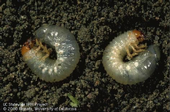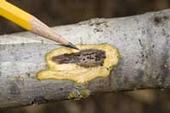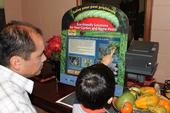![Adult opossum. [L. Fitzhugh]](https://ucanr.edu/blogs/UCIPMurbanpests/blogfiles/33175small.jpg)
It's not uncommon to see opossums running through your backyard or neighborhood. Opossums are small, house cat-sized animals that have coarse, grayish fur, a pointed face and round, hairless ears and a long, hairless tail. Their feet resemble small hands with five widely spread fingers.
Opossums may visit vegetable gardens, compost piles, garbage cans, or food dishes intended for dogs or cats. They also eat fresh meat and carrion and often feed on road kills.
In urban and suburban areas, opossum can become a nuisance as they often get into fights with dogs and cats and can inflict serious injury. Opossums carry several diseases such as tuberculosis, toxoplasmosis, trichomoniasis and Chagas disease. They may also have...
![Remove mummies (shown next to ripe fruit) and other diseased plant parts to reduce plant disease spread. [J.K. Clark]](https://ucanr.edu/blogs/UCIPMurbanpests/blogfiles/33073small.jpg)
Fall is the best time to protect your backyard fruit and nut trees from winter and spring pests. By implementing good sanitation practices now, you can help eliminate future disease, vertebrate, and insect pests.
Did you know that fruits and nuts left on the ground and hanging in trees (called “mummies”) are an open invitation to pests? As the weather begins to turn cold, pests look for a safe place to overwinter and/or to lay eggs, and mummies are an ideal shelter for them. Fungi and bacteria present in mummies also remain in dormant and active states.
Keep your fruit trees healthy by removing and disposing of all mummies in and around trees, shrubs and vines.
Other practices to reduce pest problems...
- Author: Andrew Mason Sutherland

[From the July 2015 issue of the UC IPM Retail IPM Newsletter]
Insect pests, though actually quite rare in well-managed lawns and turf, can sometimes jeopardize a flawless appearance, potentially sending people running to their local nursery or garden center for help.
The recently revised UC IPM Pest Note: Lawn Insects can prepare you with answers to keep lawns pest-free and BBQ ready this summer. This resource contains a wealth of information about lawn insect...
- Author: Karey Windbiel-Rojas

As you plan the last few camping trips of the summer, remember: buy firewood when you get to your destination. Don't move firewood! Buy it where you burn it.
Why?
Simply, we don't want wood-boring pests and diseases to be moved from one area in the state to another area where they don't exist. Buy wood where you intend to burn it and don't bring any wood home with you upon your return.
Several beetles that bore into trees such as the gold-spotted oak borer, polyphagus shothole borer, walnut twig beetle, and others may be present in the wood you gather or buy in your area. If you buy or gather wood and then take it with you to another...
- Author: Cheryl Reynolds

National Hispanic Heritage Month (September 15 – October 15) celebrates the contributions, culture, and history of Hispanic and Latino Americans originating from Spain, Mexico, Puerto Rico, Central America, and South America. These Americans make up the largest minority group in the United States and represent a very important part of the UC Statewide IPM Program's audience.
In recognition of National Hispanic Heritage Month, we'd like to highlight several important resources available from UC IPM to help Spanish-speaking audiences manage pests and apply pesticides safely.
For our Spanish-speaking urban...


